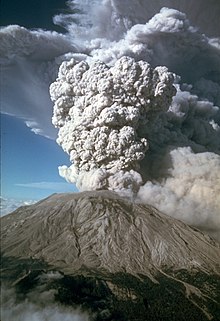User:Geohawk12/Sandbox

An explosive eruption is a volcanic term to describe a violent, explosive type of eruption. Mount St. Helens in 1980 was an example. Such an eruption is driven by gas accumulating under great pressure. Driven by hot rising magma, it interacts with ground water until the pressure increases to the point at which it bursts violently through the overmantle of rock. In many cases, the rising magma will contain large quantities of partially dissolved gas. Sometimes a lava plug will block the conduit to the summit, and when this occurs, eruptions are more violent. With the sudden release of pressure following the initial explosion, the gas comes out of solution violently and explosively. This secondary explosion is often far more violent than the first one; the rocks, dust, gas and pyroclastic material may be blown 20 km into the atmosphere at rate of up to 100,000 tonnes per second,[citation needed] traveling at several hundred meters per second. This cloud will then collapse, creating a pyroclastic flow of hot volcanic matter.
Stages of an Explosive Eruption[edit]
An explosive eruption always begins with some form of blockage in the crater of a volcano that prevents the release of gasses trapped in highly viscous andesitic or rhyolitic magma. The high viscosity of these forms of magma prevents the release of trapped gasses. When this type of magma flows towards the surface pressure builds, eventually causing the blockage to be blasted out in an explosive eruption. The pressure from the magma and gasses are released through the weakest point in the cone, usually the crater. However, in the case of the eruption of Mount St. Helens, pressure was released through the side of the volcano, rather than the crater.[1]
The sudden release of pressure causes the gasses in the magma to suddenly froth and create volcanic ash and pumice, which is then ejected through the volcanic vent to create the signature eruption column commonly associated with explosive eruptions. The size and duration of the column depends on the volume of magma being released and how much pressure the magma was under.
Pyroclastic Flows[edit]
Pyroclastic flows occur towards the end of an explosive eruption, as pressure begins to decline. The eruption column of ash is supported by pressure from the gasses being released, and as the gasses are depleted, pressure falls and the eruption column begins to collapse. When the column collapses, ash and rock fall back down to the ground and begin to slow down the slopes of the volcano. These flows can travel at up to 80km per hour, and reach temperatures of 200° to 700° celsius. The high temperatures can cause combustion of any flammable materials in it's path, including wood, vegetation, and buildings. When snow and ice melt as a part of an eruption, large amounts of water mixed in with the flow can create lahars. The risk of lahars is particularly high on volcanoes such as Mount Rainier near Vancouver, Washington.[2]
Kīlauea[edit]

Despite it's reputation for gentle eruptions, Kīlauea has had a history of explosive eruptions. These eruptions are believed to be tied to the lava lake in the Halema'uma'u Crater[3] and ground water levels. When the level of lava in the lake falls below the water table. Rock and debris from the crater walls collapse and create a blockage in the lava tube leading up to the crater. When the groundwater interacts with the lava, pressure builds and blasts the blockage out in an explosive eruption. While generally rare, this has occurred several times in the history of the volcano, and as recently as 2008.
Supervolcanoes[edit]
The eruption of supervolcanoes is the rarest of volcanic eruptions but also the most destructive. The timescale between these eruptions is generally marked by hundreds or thousands of years. This type of eruption generally causes destruction on a continental scale, and can also result in the lowering of temperatures world wide. The only super volcano known to exist in the continental United States is the caldera that powers the geothermal features at Yellowstone National Park in Wyoming.
See also[edit]
References[edit]
- ^ Skinner, Brian J. (2004). Dynamic Earth: An Introduction to Physical Geology. John Wiley & Sons. Inc. Hoboken, NJ. ISBN 9780471152286.
- ^ http://volcanoes.usgs.gov/hazards/pyroclasticflow/index.php
- ^ http://pubs.usgs.gov/fs/fs132-98/
